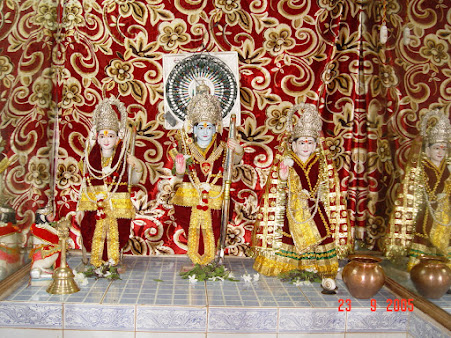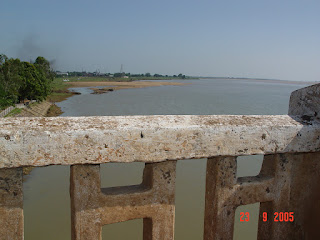Where Moon, Muruga, Dasaratha, Arjuna and Manmatha-Rathi were freed of their sins
We weave our way through narrow winding roads before coming upon the ancient Treta Yuga temple - Sri Amirthambigai sametha Sri Chandrasekara Swamy Shiva temple at Kamakkur. The place of worship that remained unknown for several centuries and was in a dilapidated state, was renovated by King Jayamkonda Chozha in the 11th century CE. He was ordered to do so by Lord Shiva himself through a vision he had. A Thiruppugazh sthalam where Lord Muruga was glorified by the 15th century Tamil poet-saint Arunagirinathar, the temple enjoys several distinguishing features and is associated with many interesting legends.
The presiding deity Lord Shiva who became self-manifest here, goes by the name Sri Chandrasekhara, having enabled Chandra or Moon to rid himself of the curse he incurred at the hands of Daksha. According to legend, Chandra or Moon, who is the lord of the 27 Nakshatras or the 27 daughters of King Dakshan, was particularly biased towards Rohini to the exclusion of his 26 other wives. An infuriated Dakshan, cursed Chandra whereby he lost his beauty and became ugly and repulsive. When a saddened Chandra sought Lord Shiva in Kailash and pleaded to be liberated from the curse, Shiva ordered him to dig a pond and perform abhisheka with its sacred water at Kamakkur when he, Shiva, himself would become self-manifest. The Lord further instructed Chandra to purify himself with the abhisheka water. At the appropriate time as indicated by Shiva, Chandra carried out his command to the last letter. Exactly upon the completion of one mandala, Shiva appeared before Chandra at Kamakkur and redeemed him of the curse. An elated and relieved Chandra sought a favour from Shiva for the benefit of mankind: that those suffering from stree and pitru doshas or curse, should be freed of it if they perform Rudrabhishekam here and bathe with its water. The Lord agreed.
In similar manner, Lord Muruga, King Dasharatha, Arjuna and Manmatha-Rathi were relieved of their respective curses. Thus emerged five holy ponds namely, Chandra, Kumara, Dasharatha, Arjuna and Manmatha-Rathi Theerthams. Unfortunately, only one of them remains today, and is replete with lotus flowers.
Lord Chandrasekhara in Lingam form, slightly tilted towards Ishana direction and growing in very minute fractions, rests here on a square peetam unlike in other Shiva temples where Lingam is placed on a circular peetam or pedestal. According to the priest, when abhishekam is performed to the Lingam, devotees experience the Lord’s grace in different ways – some get His Divine darshan with his tresses tied, some with his three eyes open, yet others see him as a serpent.
This kshetram which has been sanctified by demigods and Siddhas who performed austerities and worshipped Lord Shiva here is considered to be on par with Kashi. A pilgrimage undertaken to Kamakkur bestows upon one the benefits obtained from visiting Kashi. As the story goes, when an individual was once travelling to Kashi with an asthi (ashes of a departed one) kalash, the bone pieces miraculously turned into Arali Poo (Oleander blossom) and since then, this place has been deemed as sacred as Kashi.
Goddess Amirthambikai in standing posture is in a separate shrine. However, the eye-catching sannidhi is that of Goddess Kamakshi Amman or Tripurasundari who was consecrated and installed here by Adi Shankaracharya in the 8th century, along with the Sri Chakram during the Chaathurmaas period. Seated in Padmasana, she is depicted holding the Neelotpala flower (Blue water lily, symbol of Bhumi Devi or Mother Earth), sugarcane, and the pasham (rope/noose) and ankusham (goad) in her four hands.
Opposite Sri Kamakshi Amman’s sanctum is a small open-on-all-sides structure which holds a green stone Yazhi (Yali).
After worshipping the shrines of the Sahasralingam, Surya and Chandikeshwara and Maha Nandi, we head to the Valli-Deivanai sametha Muruga sanctum.
The six-faced Lord Shanmukha or Karthik faces the North and is perched on his mount, the peacock. A distinguishing feature of the idol, not seen anywhere else in the world is a serpent’s tail gripped by the peacock in its mouth! Also, on the snake’s hood is present the imprints of Muruga’s lotus feet.
Just as distinctive as the Muruga idol is the statue of Nataraja, the dancing form of Shiva. Unlike in other shrines, here Nataraja is seen with his left leg on the floor and the right leg is placed from the back of the left one in twisted form, in Chatura Thandavam Mudra as it is known in dance terminology. Such an idol of the deity is present only in this temple according to the priest.
The green stone Kala Bhairava image is exceptional here with the moon on his forehead, and ears having kundalam and stud respectively.
In its heydays the temple had a golden kalash atop its vimanam, lost to looters in time. The edifice was patronized, maintained and taken care of by the Nawabs of Arcot for a significant period of time. In a shrine that once witnessed puja six times every day, worship subsequently reduced to twice daily.
Adhikara Nandi, Maha Vishnu, Vishnu Durga, Iyyappa, Muniswara and the Nayanmargals or Shaivite saints also adorn the temple complex.
Specialties associated with the temple:
This is the first of the 4 sacred shrines (Devikapuram, Vedapurishwara in Cheyyar, Tiruvannamalai being the other 3) where poet saint Arunagirinathar sang in praise of Lord Muruga (Thirupugazh)
The dhwaja sthambam or flagstaff of the temple has Nandi seated atop, a feature unique to this temple.
After Thingalur, this is the second parihara sthalam for those who have a weak Chandran (Moon) in their horoscope.
For those suffering from the mal-effects of pitru and stree shraap or curse, visiting this temple, performing Rudrabhishekam for Lord Chandrashekhara and subsequently bathing in this water, will free them of the curse.
To rid oneself of the ill-effects of Mars in their horoscope (Mangal/Kuja dosha): worshipping Lord Muruga in the temple on Tuesday with 3 Kalasham, red vastram (red cloth), red oleander flower (Arali poo) and doing parayanam of Subramanya Stuti, is said to be beneficial.
On the midnight of every Chitra Pournami (Full Moon day of the month of Chaitra – mid April to mid May) one can hear the tinkle of bells and anklets in the interior of the temple complex. Devotees plagued with any kind of problems, ask prashnam(questions) at the sanctum sanctorums of Goddess Kamakshi and Chandrasekhara Swamy to which the Divine indicate a solution.
Those facing marriage hurdles, facing issues related to property and financial problems, individuals suffering from various ailments, childless couples are said to find amicable solution to their problems by visiting the temple, and/or undertaking homas et al.
Facts at a Glance:
Sthala Vriksham: Magizham tree
Pushkarini: The temple which was once surrounded by 5 ponds, has a single one left today. However, this pond, replete with lotuses has not dried up since its origin in the Ramayana time period.
Festivals: Pradosham, Sankatahara Chaturthi, Amavasya are regularly observed with all associated rituals. Maha Shivaratri, Ten-day Brahmotsavam during the Tamil month of Panguni (Chaitra/Phalguna according to Hindu calendar, that is, March/April), Aippasi Pournami (Full moon of Octobetr-November) are celebrated with much fervour and fanfare.
Location: The temple is located on the Arani-Pada Veedu route in Tamil Nadu. It is 5 km from Sedarampattu Railway Station, 8 km from Arani, 16 km from Pada Veedu, 25 km from Polur, 33 km from Vellore, 62 km from Tiruvannamalai and 131 km from Chennai.
Temple Timings: 7:00 – 11:00 & 17:00 – 19:00
Contact: Sivacharyar, the archakar (priest) @ 98418 48359 / 90872 25939






































